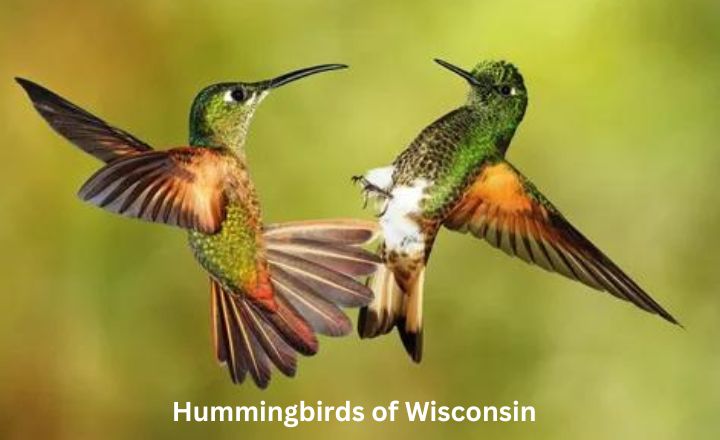Hummingbirds of Wisconsin (2 Species to know) are like elusive jewels that grace the verdant landscape of this Midwestern state. Wisconsin’s reputation for cold winters, these tiny, iridescent creatures bring a burst of color and energy to its summer skies.
In this article, we will explore two enchanting species that call Wisconsin home: the Ruby-throated Hummingbird and the Rufous Hummingbird. Let’s delve into the captivating world of these feathered marvels and uncover the secrets they hold within their fluttering hearts.
Ruby-throated Hummingbird

One of the most beloved hummingbirds in Wisconsin is the Ruby-throated Hummingbird, known for its vibrant colors and unique markings. Easily identified by their emerald-green back and bright ruby-red throat, these stunning birds are a common sight across the state during the summer months. Their energetic flight patterns and distinctive chirping sounds make them a delight to observe in gardens and wooded areas.
The range of the Ruby-throated Hummingbirds of Wisconsin extends from eastern North America down to Central America, with many individuals migrating through Wisconsin during their annual journey. These tiny wonders play an important role in pollinating flowers and helping plant diversity thrive in the region. As they flit from flower to flower, their iridescent plumage sparkles in the sunlight, creating a magical sight for anyone lucky enough to spot them in action.
This species primarily feeds on nectar from flowers, using their long bills to reach deep into blossoms. Besides nectar, they also consume insects as a source of protein, making their diet diverse and well-balanced. The best places to spot these mesmerizing birds in Wisconsin are gardens with abundant flowering plants or hummingbird feeders filled with sugar water. One of the most iconic finches in Michigan is the American Goldfinch. Get all the info about finches in Michigan.
Rufous Hummingbird

One of the two hummingbird species found in Wisconsin is the Rufous Hummingbird, known for its vibrant reddish-orange plumage and swift, agile movements. Rufous hummingbirds can easily be distinguished from other species because of their distinctive coloration and iridescent feathers. Their quick movements and high-pitched chirps make them a joy to watch as they flit from flower to flower in search of nectar.
These small yet resilient creatures travel thousands of miles each year from their breeding grounds in western North America to their wintering grounds as far south as Mexico. The range of the Rufous Hummingbird has one of the longest migration routes among hummingbirds. These incredible birds travel from their breeding grounds in Alaska and western Canada to wintering grounds as far south as Mexico and Central America.
Wisconsin may not be the first place that comes to mind when thinking about hummingbirds, but two species are known to frequent the state – with one being the Rufous hummingbirds of Wisconsin. This tiny bird, usually found in western North America, occasionally makes its way to Wisconsin during migration periods. Known for its vibrant orange color and feisty demeanor, the Rufous Hummingbird captures attention wherever it goes.
When it comes to diet and foraging habits, hummingbirds are truly remarkable creatures. With a need to consume their body weight in nectar daily, they also feed on insects and spiders for essential protein. Their high metabolism keeps them constantly on the move, flitting from flower to flower in search of sustenance.
Summary
Hummingbirds of Wisconsin (2 Species to know) is the Ruby-throated Hummingbird and the Rufous Hummingbird brings a touch of vibrant beauty to the state’s natural landscapes. Understanding these tiny yet remarkable creatures can deepen our appreciation for the delicate balance of nature that exists right in our backyard. By learning more about their behaviors, habitats, and migration patterns, we can contribute to their conservation efforts and help ensure their continued presence in Wisconsin. So next time you spot a flash of iridescent color zipping through your garden or local park, take a moment to marvel at these fascinating birds and consider how you can support their well-being in our shared environment. Let’s work together to protect and preserve the enchanting hummingbirds of Wisconsin for generations to come.
The legality of the content on PikaShow remains unclear. Users should understand the risks involved and recognize that streaming copyrighted content without permission is illegal in many jurisdictions


